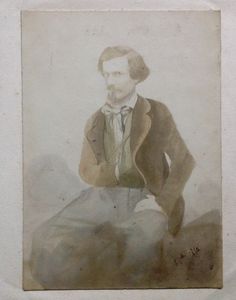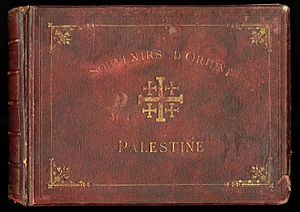Félix Bonfils facts for kids
Quick facts for kids
Félix Bonfils
|
|
|---|---|

Bonfils, self-portrait
|
|
| Born |
Félix Adrien Bonfils
8 March 1831 Saint-Hippolyte-du-Fort, France
|
| Died | 9 April 1885 (aged 54) Alès, France
|
| Occupation | Photographer and publisher |
| Years active | 1867- |
| Known for | early Middle East photography |
| Spouse(s) | Marie-Lydie Cabanis (m. 1857) |
Félix Adrien Bonfils (born March 8, 1831 – died 1885) was a French photographer and writer. He became famous for his work in the Middle East. Bonfils was one of the first photographers to take and sell many pictures of this region. He also helped use a new way to create color photographs, which was developed in 1880.
Contents
The Life of Félix Bonfils
Félix Bonfils was born in a town called Saint-Hippolyte-du-Fort in France. He later passed away in Alès, another French town. When he was young, he worked as a bookbinder. This means he put books together.
In 1860, Bonfils joined a special trip to the Levant. This area includes countries like Lebanon and Syria. France organized this trip after a conflict in Mount Lebanon and Damascus. It was a difficult time for Christians there.
After this trip, Bonfils learned a special printing method called heliogravure. He then opened his own printing office in Alès in 1864. Soon after, he became a photographer.
Family and the "Maison Bonfils" Studio
In 1857, Félix Bonfils married Marie-Lydie Cabanis. They had a son named Adrien. When Adrien became sick, Bonfils remembered the beautiful green hills around Beirut. He sent his son and wife there to help Adrien get better.
In 1867, the whole family moved to Beirut. There, they opened a photographic studio called "Maison Bonfils." This studio became very successful.
Photographing the Middle East
The "Maison Bonfils" studio took thousands of pictures of the Middle East. Félix worked with both his wife, Lydie, and his son, Adrien. In 1878, their studio changed its name to "F. Bonfils et Cie."
They photographed many different things. They took pictures of beautiful landscapes and people's portraits. They also created posed scenes with people dressed in Middle Eastern clothes. Some photos even showed stories from the Bible.
Bonfils traveled to many places to take pictures. These included Lebanon, Egypt, Palestine, Syria, Greece, and Constantinople (which is now Istanbul).
It's hard to know who took every single photo. This is because few pictures were signed. However, Lydie, Félix's wife, likely took many studio portraits. Especially those of Middle Eastern women. Women often felt more comfortable posing for a female photographer.
Adrien, their son, started taking more landscape photos when he was 17. This was when Félix went back to Alès. He went to publish their photo collections. He also opened a new printing factory there. Félix passed away in Alès on April 9, 1885.
New Photography Techniques
Félix Bonfils was one of the first photographers to use a new color printing method. This method was called Photochrom and was developed in 1880.
The "Maison Bonfils" studio was one of the busiest in the Middle East. It was active in the late 1800s. Even after Félix died, his family kept the studio going. Adrien managed it first, then Lydie, until she passed away in 1918.
Félix Bonfils' Famous Works
After moving to the Near East, Bonfils took many panoramic photographs. These were wide, sweeping pictures of places like Constantinople and Damascus. Tourists loved his work. They bought his photographs as souvenirs of their travels.
In 1872, he published an album called Architecture Antique. He showed some of his pictures to the Société française de photographie first. Later, he reopened a studio in Alès, France. From there, he published his most famous work, Souvenirs d'Orient.
Books by Bonfils and His Family
- Bonfils, F., Architecture antique : Égypte, Grèce, Asie Mineure, 1872
- Bonfils, F., Catalogue de vues photographiques de l'Orient, 1876
- Bonfils, F., Souvenirs d'Orient, 1878
- Bonfils, F. (with Adrien & Lydie Bonfils), Photographs of the Middle East, circa 1860s-1900s
L’Orient des Bonfils (1867-1918) Book
On May 11, 2017, the family of Bonfils donated many old photos. These included pictures by Félix, Marie-Lydie, and Adrien Bonfils. They gave them to the Egyptology library in Paris, France.
These photos and information about them were published in a book in 2022. It is called L’Orient des Bonfils (1867-1918). Les archives Bonfils de la bibliothèque d’égyptologie du Collège de France. This book has 865 pages and 461 black-and-white or colorized photographs. You can buy a printed copy. It is also available for free online. This helps more people learn about these important historical photos.
Selected Photographs
Where to See His Work
Many museums and libraries around the world have Félix Bonfils' photographs. Here are some of them:
- Brooklyn Museum
- Collège de France, Library of Egyptology
- Fine Arts Museums of San Francisco
- Fred Jones Jr. Museum of Art, University of Oklahoma
- Harvard University Fine Arts Library
- J. Paul Getty Museum
- Minneapolis Institute of Arts
- Nelson-Atkins Museum of Art
- Sursock Museum, with digital copies of this collection held in the Jafet Library of the American University of Beirut and the British Library Endangered Archives Programme.
- University of Michigan Museum of Art
- University of Tennessee, Knoxville
- Victoria and Albert Museum
- Virginia Museum of Fine Arts
See also
- History of Photography
- List of Orientalist artists
- Orientalism













